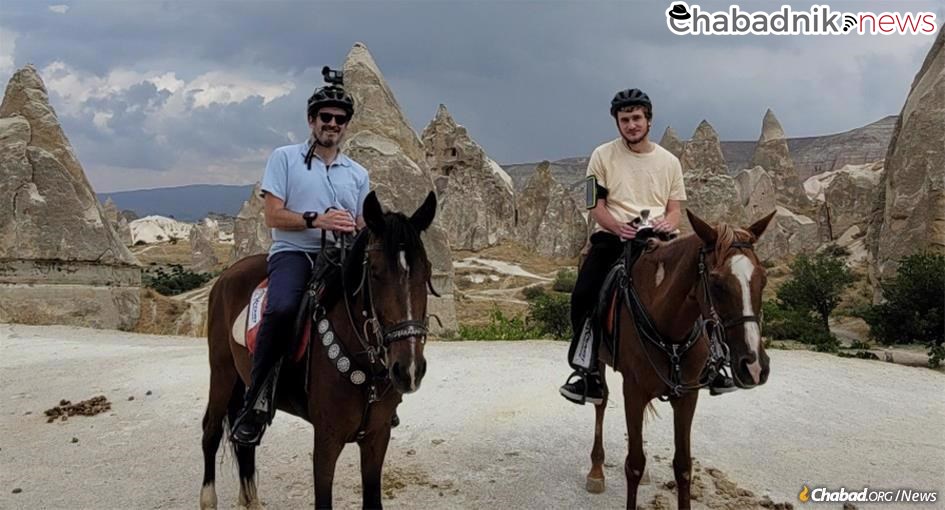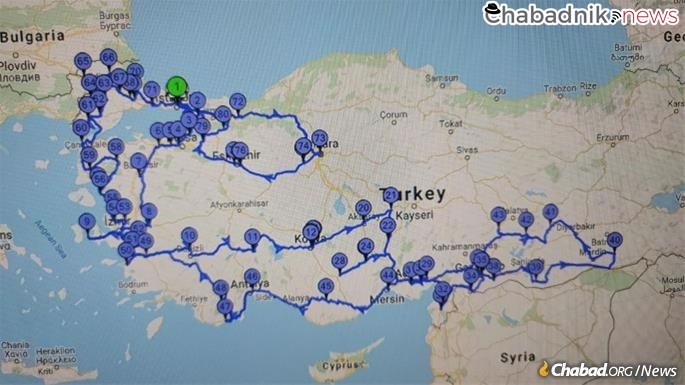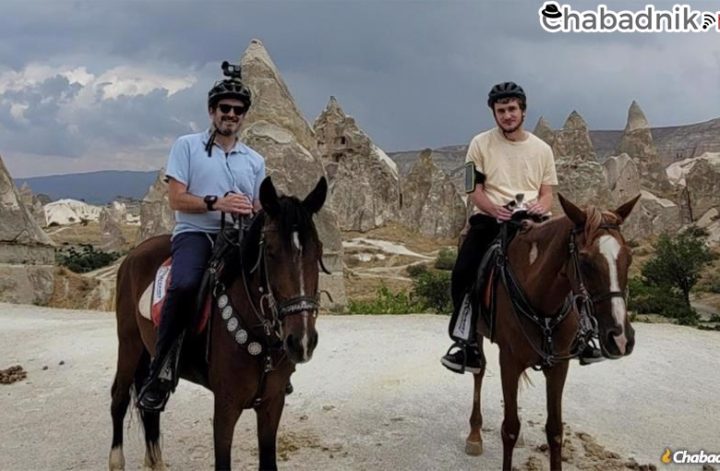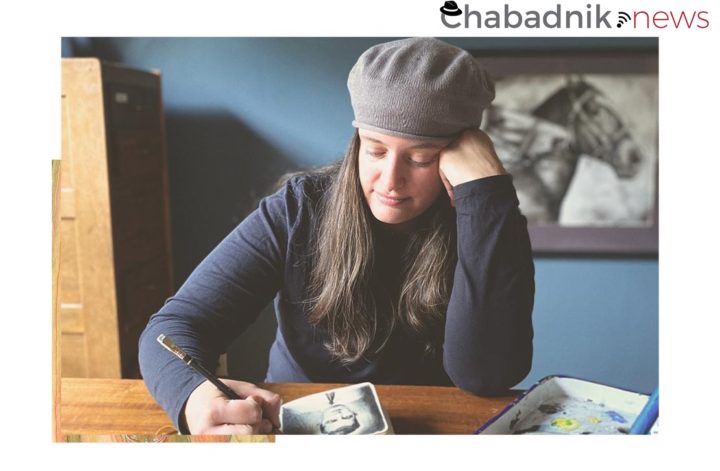Istanbul’s Rabbi Mendy Chitrik tweets his three-week trek across centuries of Jewish life

Sometime between the first and second centuries, a discussion was brewing in ancient Israel among the rabbis of the Mishnah. The burden of history and future lay on their shoulders; millennia of Jewish tradition would be based on their word. On this day, the scholars were debating Shabbat candles. “One may not light with anything that originates from a tree,” declared Rabbi Yishmael. His colleague, Rabbi Yishmael Ben Beroka, disagreed. “One may only light with a substance that comes from a fruit,” the sage ruled. Yet a third rabbi held otherwise: “One may only light with olive oil,” said Rabbi Tarfon.
Rabbi Yochanan Ben Nuri stood up on his feet and countered the three sages. “What shall the people of Babylonia, who only have sesame oil do?” he asked them, listing off several more regions and their fuel options. “And what shall the people of Cappadocia do, who have neither this, nor that, but only naphtha, do?” he concluded, ruling that all oils that weren’t explicitly prohibited by the earlier sages are permissible for Shabbat candles.
“You may not be familiar with Cappadocia,” Rabbi Mendy Chitrik tells me, “but you certainly are familiar with paraffin wax (naphtha) Shabbat candles.”
Chitrik, 44, rabbi of Istanbul’s Ashkenazic community and chairman of the Alliance of Rabbis in Islamic States, was two weeks into a three-week road trip across more than 5,000 miles of Turkish countryside, together with his 18-year-old son, Chaim, a student at the Chabad-Lubavitch rabbinical college in Los Angeles, and visiting nephew, Eliezer Schurder, when he spoke with Chabad.org, from Cappadocia, Turkey, whose ancient Jewish community Rabbi Yochanan Ben Nuri was so concerned about almost 2,000 years ago.

A Journey Through the Past and the Present
Chitrik’s journey is about more than retracing Turkey’s rich Jewish history, the rabbi explains, “It’s about meeting living Jews, Jewish history and supervising kosher food production in Turkey,” where Chitrik, among his other communal and rabbinic duties, oversees kosher supervision for the Turkish Chief Rabbinate (KTR) and on behalf of international kosher certification agencies such as the OK and OU.
Chitrik is far from a mere observer of Turkey’s Jewish heritage; he lives and breathes it. Serving as the Chabad rabbi of the Istanbul Ashkenazic community since 2001—with the help of his wife, Chaya, and their eight children—he is fluent in six languages, among them, Turkish and Ladino, a Judeo-Spanish language once spoken around the world by Sephardic Jews, but not often heard today. Chitrik teaches one of the few Ladino Torah classes in the world. After two decades, the rabbi is an expert on Ottoman Jewish history and has made several such journeys in the past.
I spoke with the busy rabbi hours before Shabbat in Cappadocia, where he would be spending Shabbat before continuing on to Kayseri, a city where the Talmud records 12,000 were killed during a revolution. Today, nothing remains of the once-large Jewish community there. “We’re recording Jewish footsteps,” remarks Chitrik. “I want to bring these sites to the attention of the local Muslims and Jews. We’ve shared this ground for thousands of years.”
Engaging the Muslim community in his travels—and in his regular life in Istanbul—is another focus of the dynamic rabbi. “We need to show them that wecare about our history—preserving our ancient synagogues, maintaining our cemeteries—if we want others to respect those sites.”
Early on in the trip, Chitrik met up with Imam Osman Demirel of Akhisar and Imam Yasar Yuksel in Manisa, a modern, bustling center of industry in Turkey’s Aegean region. The rabbi was introduced to Demirel by a former student of the imam’s, Selim Öztürk, the cultural attaché at the Turkish Embassy in Tel Aviv. “He will help you find Jewish traces,” Öztürk advised the rabbi. “And so it was … ,” Chitrik wrote on Twitter, “Imam Osman and myself are roaming around the dusty streets. ‘I am an Imam, he is a rabbi’ he tells everyone. ‘We are related through Adam.’ ”
Thank you Imam Osman and Imam Yaşar for taking us in as your guests, thank you Selim Ozturk for introducing us to each other!
— Rabbi Mendy Chitrik (@mchitrik) July 29, 2021
2 imams and 1 rabbi and a lot of common ground… pic.twitter.com/qhJH2io9Vc
The unlikely duo scoured Manisa for its vibrant Jewish past, searching for traces of some of the great scholars who lived there. The last Hakham Bashi (“chief rabbi” in Turkish) of the Ottoman Empire, Haim Nahum Effendi, was born here. “Rav Haim Nahum was a colorful personality,” explains Chitrik, “who resigned from the Turkish rabbinate in 1920 to take up a position as chief rabbi of Egypt, where he served until his death in 1960. He was a one-of-a-kind character, whose counterparts had varying views on his capabilities as a rabbi or his religious convictions and practices. Well,” the rabbi adds, “being a professor of Arabic and working with Nasser certainly didn’t help his rabbinical standing.”
Unfortunately, the location of the old Manisa synagogue was lost to history, so the rabbi and imam set off to find the Jewish cemetery. “The good imam was driving back and forth until we found it!” The last burial was in the 1950s, and the cemetery is maintained by the Manisa municipality. After some prayers, they set off to discover yet another forgotten Jewish community.
Chaim, Eliezer and I said some prayers for the souls of the Manisa Jews – we also mentioned Hayim Nahum efendi (how can you be in #Manisa and not mention him) and of course the other great rabbis and scholars… pic.twitter.com/rCJbLi0zKl
— Rabbi Mendy Chitrik (@mchitrik) July 29, 2021
Twenty-five miles away, they stopped at Turgutlu, a smaller city in the region. Chitrik wasn’t aware of its historical Jewish community until the group met with the director of a local museum while sipping Turkish tea in his garden. The museum told the story of the 1922 fire that turned almost all of the city to ashes, together with its two synagogues. “It also tells the story of the 1,300-strong Jewish population,” Chitrik told the rapidly growing ranks of his Twitter followers, “Yakov Bencoya, Alberto the musician and scores of others. Real-life examples of coexistence.”
Sitting down for another tea before moving on, their tea break became a town-hall discussion with the local director of education, a school principal, local historians—“all children of a Jewish neighborhood,” Chitrik tweeted in Turkish.
The assortment of strangers, now fast friends, began to reminisce about growing up surrounded by Jewish neighbors.
"My father would light the candles in Jewish houses on Saturdays" said Mehmet Olmez… "My father did too! They used to get 5 kuruş for it!" said another… "The second floor of my home was used as a Midraş, until the synagogue was built" and "Bencoya was known for charity"… pic.twitter.com/adIIzaqOMN
— Rabbi Mendy Chitrik (@mchitrik) July 29, 2021
After some more tea and friendly banter, Chitrik and his entourage were ready to head to Sardis. Sardis is the oldest Jewish settlement in the region of Anatolia, which makes up most of modern-day Turkey, dating back to 700 BCE. Jews came here from Israel, exiled by Sancheriv. In 1962, archeological digs by the Harvard-Cornell Sardis Expedition uncovered the ruins of a magnificent, ancient synagogue. With ample room for 2,000 people, the synagogue tells the story of a large and thriving Jewish population that lived here.
This ancient synagogue in Sardis, is the oldest in Europe, and is more than 1200 square meters in size – it could hold close to 2000 worshipers at a time…
— Rabbi Mendy Chitrik (@mchitrik) July 29, 2021
Teomen tells us that a new roof is being constructed, to protect the beautiful mosaics from the elements… pic.twitter.com/CYCMmojVZF
The synagogue has all the trappings of a modern synagogue: an ark, a teiva (as the table used to read the Torah was known then), seats for the elders and even a list of donors engraved in stone, preserved until today.
Synagogues aren’t in short supply in Turkey, and one place with some of the most grand synagogues is Izmir. Izmir was founded by the Greeks, who knew it as Smyrna. Izmir was home to many great scholars and sages—one of the better-known being Rabbi Chaim Palagi, 1788-1868, who authored more than 70 books, including Kaf Hachaim, an authoritative text on Jewish law still in use.
The false messiah—the infamous Shabbtai Tzvi—was born in and “revealed” himself in Izmir in an episode that roiled the Jewish world.
The Jews, lived right here, on the slopes of Pagos, all the way down to the seashore… Merchants, fishermen, rabbis, mystics, Kabbalists, converts, diplomats, beggars – even a Messiah – all left their marks, in tue heart of the city and the heart of the Jewish nation… pic.twitter.com/LW6LakahRE
— Rabbi Mendy Chitrik (@mchitrik) July 28, 2021
Chitrik spent a Shabbat in Izmir, enlivening the local community. “There are 1,200 Jews living in Izmir,” the rabbi tells me. “They have chazzanim [‘cantors’], but no rabbi. I spoke at the Shaar Ashamayim synagogue about the importance of prayer and of our responsibilities to each other.”
The rabbi finds it important to record local, unique Jewish customs; in Izmir’s Bikur Holim synagogue, he noted that a goral, or “lot,” was drawn to determine which Torah scroll would be taken out of the ark to be read.
Why do you need a lot, a Goral, for a Torah? The Talmud says, that "Everything depends on luck *even a Torah scroll in the Arc*" – sometimes the one Torah in the back, never gets taken out… So they made a Lot which Torah should come out… The last lot – the last was in 1971… pic.twitter.com/siHFe8cilO
— Rabbi Mendy Chitrik (@mchitrik) July 28, 2021
At Izmir’s Neve Shalom synagogue, the rabbi notices a large Hebrew plaque at the entrance. The plaque states that this synagogue was built according to the customs of Rabbi Bate Kehunah. Rabbi Bate Kehunah refers to the title of a book authored by Rabbi Yitzchak Hakohen Rapoport, who served as the chief rabbi of Izmir until 1749, when he moved to Jerusalem, taking up the position as Rishon LeTziyon, or chief rabbi, the only Ashkenazic Jew to have ever held the illustrious post.
Chitrik explains that each Jewish community in the Diaspora has its own unique customs, differing even from nearby communities. “Over time, they developed various customs that distinguish one community from another. The tune in which one reads prayers in Izmir isn’t exactly the same as in Istanbul.”
Rabbi Rapoport, born in Jerusalem in circa 1705, arrived in Izmir to fundraise from the local community. The Izmir Jews were so taken and impressed by the sage that they begged him to stay on as their own chief rabbi. His personal Ashkenazi customs were incorporated in the Neve Shalom synagogue, a testament to the high regard in which he was held.
Back to this Shabbat: prayers were led by Hazzan Beruhiel who is originally from Istanbul – who follows the Istanbuli custom. Moshe L. wants that procedure should follow local Izmirli custom!
— Rabbi Mendy Chitrik (@mchitrik) July 31, 2021
See, customs are the 'spice' of practice, but there are inevitable influences at times
“Many are familiar with Ashkenazic, Sephardic and Mizrahi Jews,” explains Chitrik, “but not many have heard of Romaniote Jews.” Roughly translated as Jews of the Roman/Byzantine Empire, they precede both Ashkenazic and Sephardic Jewry. They lived in Anatolia for thousands of years, and some Istanbul and Izmir Jews are their descendants.
The ruins of the Sardis synagogue belong to a large Romaniote community, and the next town on the itinerary was also a Romaniote stronghold.
Priene, an ancient deep-water port city, lay on the Aegean coast. Forgotten by time, antiquated marble structures dot the landscape; and grand theaters, Roman baths, Greek stadiums and a fourth-century synagogue with carvings of a menorah are still visible near the synagogue’s ark.
But #Priene's jewel for me is of course the synagogue… Built in the 4th century and served the Romaniote Jewish community for close to 500 years. pic.twitter.com/leR2wcpl7Z
— Rabbi Mendy Chitrik (@mchitrik) August 1, 2021
After praying the Mincha service on the ruins of the ancient synagogue, just as these Romaniote Jews had done thousands of years before, they headed off to nearby Milas.
Full of old-world charm, it too, once hosted a Jewish community. At the Jewish cemetery, Chitrik found graves from 1710 through 1987—some ornate, others just a slab of concrete. The municipality had walled off the burial ground, keeping it well-preserved.
But what they found next shocked them. Beyond the walls of the cemetery, a construction project was taking place, and they found desecrated graves and human bones littering the earth.
The rabbi’s son and nephew got to work burying the bones, giving these remains the respect they deserve.
Eliezer and Chaim volunteered for the Mitzva and tried to bury the human bones that we found…
— Rabbi Mendy Chitrik (@mchitrik) August 1, 2021
It would be great if the @muglabsb and the @MilasBelediyesi would take more caution in respecting the souls of the Jewish citizens of #Milas… pic.twitter.com/0qDtVo7m4H
But was Milas’s Jewish cemetery the only testament to a world that once was?
They sought out the Milas synagogue only to discover that it had been razed several years before; an education center now stands in its place.
Not ready to give up on discovering signs of Jewish life, around the corner from the synagogue they spied an old house, with a telling sign of the identity of its former occupants.
It's current residents didn't appreciate us intruding… pic.twitter.com/xZeCEZjcjA
— Rabbi Mendy Chitrik (@mchitrik) August 1, 2021
Above the door was inscribed “Yosef de Abuahav of Milas, 5640 (1880)” in Hebrew. The boys snuck into the abandoned house, followed reluctantly by their father and uncle. The marks of a mezuzah were still evident.
A worried neighbor came out and warned us of ghosts, spirits, scorpions and snakes that reside in the abandoned house… So we quickly got out (who wants to mess with any of these?!)… pic.twitter.com/8W0kVWf9MV
— Rabbi Mendy Chitrik (@mchitrik) August 1, 2021
History is of much significance for us today, Chitrik feels. “We’re about the present and the future,” he notes, “but if we know our history, it can shape our future, shape our lives.”
Present-day Turkish Jewry is largely descended from Spanish Jews who fled the inquisition and forced conversions to Christianity to openly practice their faith in Turkey. “Nobody threatened their lives in Spain; it was their souls, not their bodies,” he said. “Those who chose to live openly as Jews came here. When we learn of the sacrifices of our forefathers to come here with these hardships, it gives a sense of commitment to the future as well.
“It’s about how to apply history, preserve history to shape our future,” the rabbi continued. “One shul we visited is around 1,500 years old. When you explain to a child that Jews have prayed here for so long, the same way, he feels part of a chain stretching until Moses. Every Jew has this background. We’re carrying the weight of our history; a sense of responsibility.”
In fact, this chain goes until Abraham himself—the father of the monotheistic recognition of one G‑d. It began in Turkey, in the hills of Harran, a city of the Upper Mesopotamia of old.
Here is where the four Matriarchs lived… Rebbeca, Rachel and Leah were born right here in this city…
— Rabbi Mendy Chitrik (@mchitrik) August 11, 2021
Jacob's children: Reuven, Shimon, Levi, Yehuda, Yissachar, Zevulun, Dan Naftali, Gad, Asher, Yosef and their sister Dina – were all born right here on this hill… pic.twitter.com/qPaHeKpIa8
Where the shepherds were gathering their sheep, in those days, but also at this time… pic.twitter.com/MiEp3KileS
— Rabbi Mendy Chitrik (@mchitrik) August 11, 2021
Four thousand years later, Chitrik and his family feel welcome as they freely live in Turkey, and travel the length and breadth of the land, with a kippah on their heads, tzitzit rustling gently in the Middle Eastern winds.
While almost all of the attention he garners on social media—where many local Turks follow him, cheering him on in his journey—is positive, the rabbi was also a recipient of hatred, the kind that is as old as the land he walks upon. A nationalistic author and journalist wrote on Twitter that Chitrik’s route “overlaps with places where there are fires,” referencing the recent wildfires plaguing Turkey that have displaced thousands and killed nine in the country’s worst fire season on record. “Rabbis know kabbalah and black magic as well,” he told his 60,000 followers.
Chitrik is not intimidated. “We know we’re doing the right thing when we walk proudly as Jews. The government is taking steps to protect all the citizens and visitors of Turkey. We’re not concerned at all. It’s a reminder that we must normalize Jews walking in Turkey, as they have for 2,700 years; we need to show we’re proud as Jews.”
Judaism continues to thrive in Turkey, which is home to an estimated 15,000 Jews, most in Istanbul, with a smattering in other cities, such as the capital, Ankara, Bursa and Izmir, as well as in tiny pockets in other cities.
In Bursa, the rabbi noticed a book of communal marriage records at the Major synagogue, which some say is named after the Jews of Mallorca who found refuge here. “Still some empty pages to fill,” he says with a laugh. “Sounds optimistic to me.”
I say goodbye to the rabbi just before Shabbat in Cappadocia, “We’ll be lighting our Shabbat candles soon just the way the Jews of Cappadocia did,” he says, “continuing the tradition.”
And… Betrothal Records that still have some empty pages to fill… Sounds optimistic to me… pic.twitter.com/yytv2lGPfX
— Rabbi Mendy Chitrik (@mchitrik) July 26, 2021




